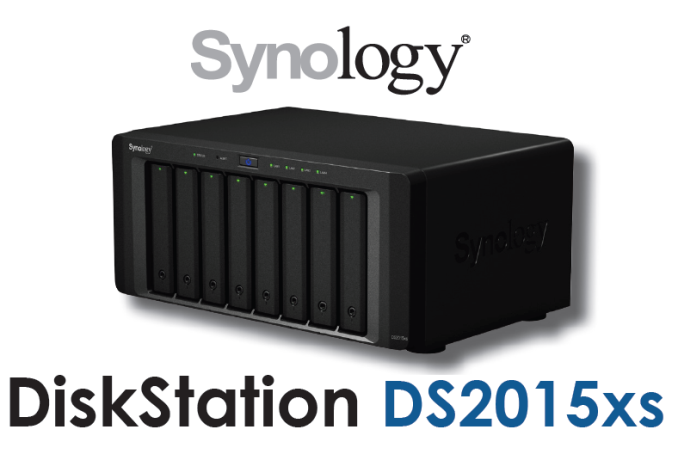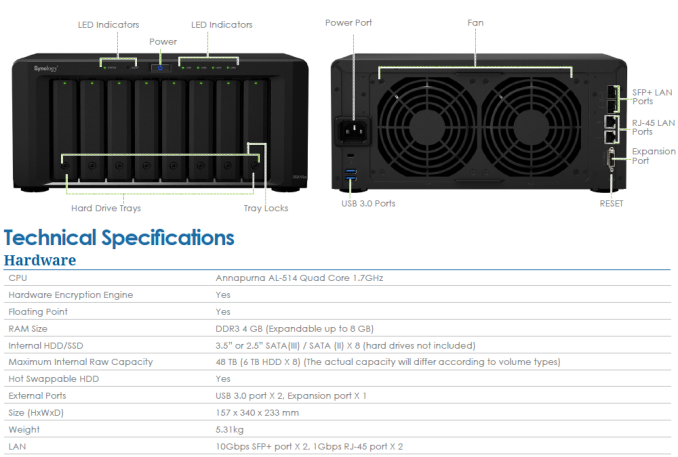Synology's DS2015xs brings ARM to High-Performance NAS Units
by Ganesh T S on December 9, 2014 3:00 AM EST- Posted in
- NAS
- Storage
- Arm
- 10G Ethernet
- Synology

In the current NAS market, it is downright impossible to talk of ARM and high performance together. The most powerful ARM-based NAS units have been based on Marvell's ARMADA processors. They usually come with dual gigabit network links and typically target the SOHO and low-end SMB market. Intel's offerings have had a virtual monopoly in the other tiers of the market. Synology is set to change all that with their latest offering - the DS2015xs with native 10G capabilities.
DS2015xs: Features & Specifications
The DS2015xs is 8-bay NAS unit presented as a step-up from the DS1815+. While the DS1815+ can expand up to a total of 18 bays with two DX513 expansion chassis, the DS2015xs is compatible with the 12-bay DX1215 expander (for a total of 20 bays). The main step-up from the DS1815+ is the presence of two built-in 10G SFP+ copper links.
Claimed performance numbers include transfer speeds of up to 2000 MBps and 59K sequenital IOPS.
Platform Details
The SoC at the heart of the DS2015xs is the AL-514 from Annapurna Labs, an Israeli startup that is still in stealth mode. The company has declined to speak to the media as of now. However, tracing some coverage of Israeli VC firms reveals that Annapurna Labs was founded in 2011 with the intent of bringing ARM-based communication processors to the market. Datasheets of SoCs from Annapurna Labs are not currently available to the public, but Synology was kind enough to divulge the following details (which, I suspect, can be gleaned via SSH access to the DS2015xs):
- The AL-514 has four ARM Cortex-A15 cores running at 1.7 GHz
- The Cortex-A15 cores are configured with LPAE (large physical address extension) that allows addressing of more than 4 GB of RAM (the DS2015xs supports up to 8 GB)
- The SoC has two 10G Ethernet MAC IPs integrated
Beyond these, details are scarce. We hope Annapurna Labs comes out of stealth mode soon and supplies us with more details. We might possibly be able to gather more information about the platform once we get the DS2015xs in hand.
Moving on to the relevance of the AL-514 for the ARM ecosystem, it is clear that at least Synology considers it to be a worthy competitor to Intel's Rangeley. The DS2015xs is being positioned as a clear step-up from the Rangeley-based DS1815+. That said, the fact is that A15 is a 32-bit processor, and it is not entirely suitable (despite the LPAE extensions) for high-performance servers. ARM has since moved on to ARMv8 processors (true 64-bit) for both the smartphone and the server / communication infrastructure market.
Related Announcements - DS3615xs and DX1215
In other related news, Synology is also launching the DS3615xs, a native 12-bay desktop form factor solution (expandable to 36 bays with support for two DX1215 expanders). It is a straight-up upgrade to the previous-generation DS3612xs which used a Sandy Bridge-based Core i3-2100. The DS3615xs uses the Haswell Core i3-4130. It comes with four gigabit links, but also has support for a PCIe expansion card (to potentially add 10G capabilities). Like the previous generation xs-units, it comes with ECC RAM (4GB DDR3 by default, expandable to 32GB). Pricing and release date in the Americas for the DS3615xs is not yet available.
The DX1215 is a 12-bay expansion unit for select Synology DiskStation models. Unlike the eSATA-based DX513, the DX1215 connects to the main unit using Infiniband. Further details are available here.
Concluding Remarks
The DS2015xs will retail for $1400 - a price that really makes 10G affordable, while undercutting the introductory pricing of the previous generation xs units significantly. We have to admit that the xs positioning of the unit was initially very surprising. After all, the Cortex A15 really can't stand up to the Core i3 (on which the previous generation xs units have been based) in terms of raw CPU performance. There is no support for ECC RAM either. Synology clarified that the CPU performance would definitely not match up. However, the presence of communication and storage accelerators - particularly, natively integrated 10G capabilities, RAID acceleration and hardware-assisted encryption - enable the DS2015xs to support bandwidths that have typically not been reached at this price point.
While the Annapurna AL-514 SoC seems more like a stop-gap solution for this market segment (particularly when true 64b ARM solutions are starting to make an appearance), consumers are fortunately shielded by Synology's DiskStation Manager (DSM) OS. The operating system manages to isolate the user experience with various NAS aspects from the underlying platform architecture. The end-user experience is the same, regardless of whether the NAS being used is based on ARM or x86.
On the whole, Synology seems to have hit a home run with the price to performance ratio in the DS2015xs. We hope to soon have a unit in hand to test out how it performs with our standardized lab environment. We would also like to hear from readers on what sort of applications they are running on their Synology NAS units. This would help us determine how much of a performance difference there is between, say, the DS1815+ and the DS2015xs, for applications that matter to end users.
Source: Synology











27 Comments
View All Comments
ganeshts - Tuesday, December 9, 2014 - link
Yes, that is what I meant - the connectors need copper cables, not fiber.mervincm - Wednesday, December 10, 2014 - link
Is it possible that the transceivers were included only for your review unit? If a pair of SFP+ 10GbaseT transceivers are included that would be a valuable add on that I didn't see in the announcement.Joshwa81 - Wednesday, December 10, 2014 - link
I use my DS1812+ as a NAS and iSCSI datastore for my test vmware server cluster. I also run Plex with transcoding which I find to be the most taxing of all the tasks. I would be very curious to know how the DS2015xs would perform with Plex as that can use a lot of CPU for large video transcoding.mervincm - Wednesday, December 10, 2014 - link
I would not be shocked to see that it was simply unavailable for an extended period, this being a new ARM COU and all that.. If it ever supports transcoding remains to be seen. most (all?) arm plex distros do not support video transcoding according to plex forum.ZarnoththeDestroyer - Monday, December 15, 2014 - link
The DS1813 does plex a little better but not enough. I think it has something to do with the people who right plex as well. Some versions stream great others just don't at all. It would be nice if you could set an application priority via Synology DSM. I believe you can set it to higher in PLEX. I have since moved the PLEX server to a VM and used the DS1812 and DS1813 for storage and other services. Plex connect with AppleTV, Roku and Xbox one work well with plex.akula2 - Thursday, December 18, 2014 - link
Standardized lab environment? What does it mean?I use various Storage solutions. E.g., SONET should give some scope of my data requirements connected between locations in three nations. Building and Integrating two Hybrid Clusters was a bigger challenge.
iAPX - Tuesday, December 23, 2014 - link
Inexpensive for probably 1200MB/s over two 10Gb ethernet links or 800Mb/s over 1 10Gb/s (my guess!), it's a killer on it's own.It's time to switch to 10Gb Ethernet, and this one might be a Thundebolt killer, at least for me and my own use (photography, backup, etc)